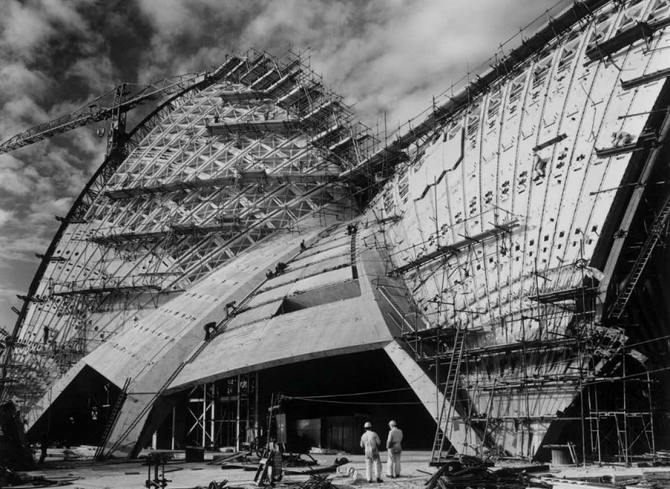
In this article we review some elements of Jørn Utzon’s architectural design philosophy as expressed in the Sydney Opera House, and its affinities with ideas enunciated by his predecessor Peter Behrens and his older contemporary, the American visionary architect Louis Kahn. In particular, Utzon’s conception of the building’s role as an essential civic institution bears a striking resemblance to the prominence given by German architect Peter Behrens some fifty years earlier to the concept of the theatre as a “secular temple”, central to civic life.
The design and construction of the Sydney Opera House, and the conflicts associated with those processes, are well documented. The building itself is seen commonly as a high point in a strand of European modernism. Yet beyond this, something deep, harking back to antiquity, has always haunted the Opera House. Like a ghost within lies Utzon’s conception of the building as a spiritual venue, realised with an eye to ancient Mayan and Greek prototypes. In the podium and shells of the Opera House he sought to evoke spiritual and aesthetic values akin to those which he attributed to the platform-temples of Mexico and the classical temple complexes. In broader terms the building may be assessed as aspiring to a quasi-religious role within the fabric of the modern city.
This essay appears in the May edition of Quadrant.
Click here to subscribe
Religious ceremony has a close affinity with what is now recognised as dramatic performance. Conversely, there have been occasions when sacramental elements and religious sentiments have been re-injected into what might otherwise be regarded as strictly secular performance. The Passion Plays of medieval Europe illustrate how spiritual and dramatic elements can be combined in a single performance. More recently, the intersection of the secular and the spiritual could be seen on the occasion of the premiere of Handel’s Messiah (1743), when it is said that King George II stood during the Hallelujah Chorus, as if in the presence of the sacred.
A theophany is a palpable manifestation of a god. In the Jewish, Christian and Islamic faiths—at least within the bounds of orthodoxy—such manifestations are confined to crucial moments of divine revelation mentioned in the scriptures; but in some other traditions they are woven into a liturgical framework that seeks communion with the deity as part of its ceremonies. The idea of the theatre-temple refers to the provision of a setting for such manifestations (by contrast, the American architectural historian Vincent Scully characterised the Parthenon as itself the body of a god, “set in the landscape and poised for a certain kind of action”.)
The theatre-temple has been a focus of attention in both Eastern and Western traditions of sacred geometry, in symbolic forms derived from spiritual and geomantic traditions. A purpose or theme here is the reconciliation of humankind with the earth. This is exemplified by the Vesica (below), the orifice formed by the interpenetration of two equal circles, of which one represents the spiritual realm, the other the world of material phenomena.
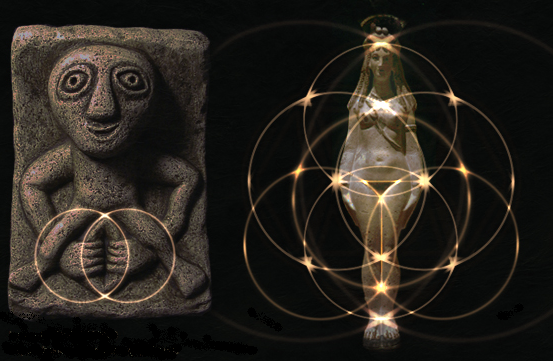
The concept of the theatre-temple was taken up in a modern form by the German architect Peter Behrens (1868–1940). Behrens began his career as a painter but turned his attention to architecture around 1899, in his work at the Künstler-Kolonie (Artist Colony) at Darmstadt. It was there that Behrens was able to elaborate a view of the theatre as of central, quasi-religious importance, the site of ceremonial occasions at which the highest spiritual values of a community might be expressed.
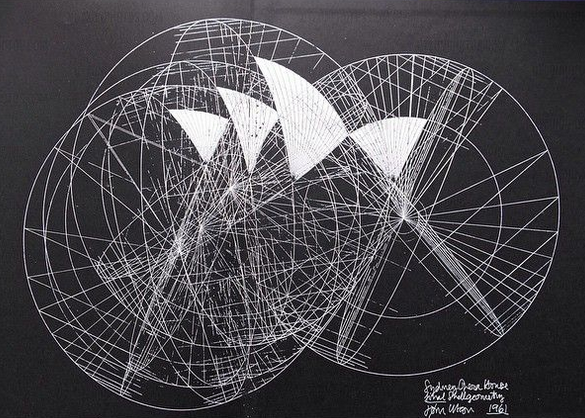
The Darmstadt Künstler-Kolonie was established under the patronage of the Grand Duke of Hesse-Darmstadt, and Behrens was one of seven artists working at the Kolonie, who saw themselves as forming an elect group, with a solemn mission to lead a rejuvenation of German art.
The term Jugendstil was applied by others to the work of Künstler-Kolonie and similar contemporary ventures, and is still often used to designate (in effect) the German branch of Art Nouveau. Such a 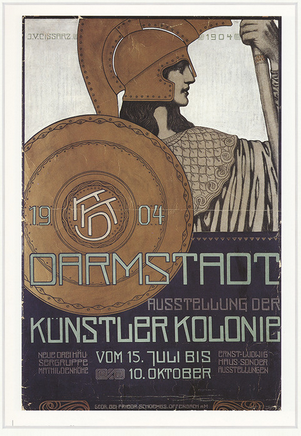 definition, however, gives only a weak sense of the group’s mission, in which style was seen not as a superficial element of their work, but as its driving force. Their mission also had a specifically Germanic edge, in that they felt themselves to be fighting in the vanguard of a renewal of Germanic culture, which in their view had sadly decayed during the preceding century of rapid political and industrial development.
definition, however, gives only a weak sense of the group’s mission, in which style was seen not as a superficial element of their work, but as its driving force. Their mission also had a specifically Germanic edge, in that they felt themselves to be fighting in the vanguard of a renewal of Germanic culture, which in their view had sadly decayed during the preceding century of rapid political and industrial development.
An essential, although not always explicit, part of motivation for this movement was Friedrich Nietzsche’s focus on the development of human capability. For Nietzsche, a superior individual must seek freedom and creative expression through constant life-affirming contention with his own base inclinations and conventional pieties. Nietzsche acknowledged that such an individual will find few of like mind, and the subsequent application of his ideas in a social context fell to a few popularisers such as Julius Langbehn, whose writings were influential especially in the subsequent enunciation of the artist’s role as one of an elite group, possessed of a visionary mission. The members of the Künstler-Kolonie certainly saw themselves in this light.
Behrens was responsible for the planning and production of the Kolonie’s solemn opening ceremony, which took place at the entrance of the main hall, at the head of a grand flight of stairs which led up from an avenue along the main axis of the site. The ceremony followed a text written by one of the founders of the Kolonie, and included scenes of hieratic grandeur, in which robed actors witnessed a prophet’s unveiling of a crystal endowed with transfigurative powers.
This was consonant with Behrens’s view of the theatre as the “highest cultural symbol”, a view partly realised in Behrens’s production of a Symbolist play at Hagen in 1909, which was supported and elaborated by like-minded poets, critics, playwrights and dramatists. He proposed radical departures from naturalistic theatrical convention, with the aim of achieving a close relationship between audience and performers, cleansed of naturalistic illusion. The audience would surround the stage on three sides, with a broad processional accessway and stairs by which actors would move through the theatre and onto the stage. Theatrical performance would be conceived as a harmonious synthesis of drama, music and dance, encompassing even the costumes of the participants in the drama.
The theatre furthermore would fill the gap left by the decline of the dominant religions, which until recently had shaped the life of the community and driven the shaping and construction of public buildings, and whose demise had been announced in Nietzsche’s dictum “God is dead”. Behrens explained the solemn “liturgical quality” that he had in mind: “If drama has derived from religious cults, then I can see a great sign for the evolving theatre style in that again poets live who can give us and our times the forms of a Cult of Life.”
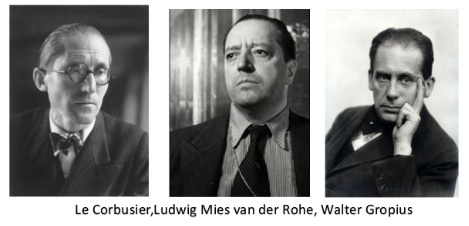
That emphasis on culture as the transmitter of spiritual values was common to a number of strands of the modern movement in the first half of the twentieth century. Behrens himself contributed through the force of personal example and reputation: in the decade following his work at the Künstler-Kolonie his architectural studio employed three men—Mies van der Rohe, Le Corbusier and Walter Gropius—who would be revered as masters of the Modern movement. In Behrens’s case the emphasis on culture was overlaid by other ideas, such as the expression of the zeitgeist—speed, automation, efficiency—in the design of factories and other industrial buildings; and this was related in turn to the Expressionism expounded by Erich Mendelssohn and Hans Scharoun and others. Beyond these ineffabilities, the architects and ideologues in the orbit of Gropius at the Bauhaus saw the need for revolutionary changes in the role of architect in the face of revolutionary changes in society: a reconciliation between the use of machines and the contribution of the craft tradition, a sense of the architect as serving the whole community, not merely a small aristocratic and upper middle-class elite.
Utzon inherited this tradition, in a distinctively humanistic Nordic form, through contact with exponents such as Steen Eiler Rasmussen, Arne Jacobsen and Eero Saarinen. We cannot say whether Utzon had any direct awareness of Behrens’s teachings or writings, yet it is a striking fact that by the time he undertook the design of the Sydney Opera House he had become an expositor of ideas which were tantamount to what Behrens had espoused. In particular, he saw the cultural works housed in the Opera House as elevated above the day-to-day life of the city, expressing the highest ideals of the citizenry. The Opera House, in his view, was to be a spiritual centre of the city, a modern embodiment of the medieval cathedrals.
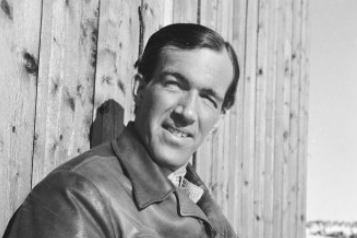 Utzon (at right in the late 1940s) belonged to a generation of modern architects whose work was driven by a desire to relate their work to the past: a continuity to be achieved not through the replication of ancient forms, but through a more inward resonance. By the 1960s it was a commonplace amongst many commentators that secular institutions had replaced the temples of organised religion as spiritual and social centres in modern society. This is certainly borne out in the case of the Opera House, both in Utzon’s use of religious buildings as formal models, and also in his statements attributing a spiritual value to the building within the urban context.
Utzon (at right in the late 1940s) belonged to a generation of modern architects whose work was driven by a desire to relate their work to the past: a continuity to be achieved not through the replication of ancient forms, but through a more inward resonance. By the 1960s it was a commonplace amongst many commentators that secular institutions had replaced the temples of organised religion as spiritual and social centres in modern society. This is certainly borne out in the case of the Opera House, both in Utzon’s use of religious buildings as formal models, and also in his statements attributing a spiritual value to the building within the urban context.
Utzon (1918–2008) did in fact mention an affinity with a Gothic cathedral: “If you think of a Gothic church, you are closer to what I have been aiming at.” To suggest that Utzon’s building is itself a temple would be to take the analogy too far. Few, however, would disagree that in its siting and formal composition the Opera House conveys a sense of separation, a pervasive “otherness” distinct from the frenetic busy-ness of everyday life in the city. And the Opera House retains that sense of separation, even after six decades of intensification of commercial activity in the CBD.
The clear separation of platform base and roof structure would symbolise in visible form the separation of their respective functions. As Utzon put it:
In the Sydney Opera House scheme the idea has been to let the platform … separate primary and secondary functions completely. On top of the platform the spectators receive the completed work of art and beneath the platform every preparation for it takes place. (Utzon, 1962, “Platforms and Plateaus: Ideas of a Danish architect”)
This separation of functions was consistent with the tenets of mainstream modernism, which dictated that the parts of a building should be allowed, in effect, to speak for themselves, rather than being merged in a pre-given architectural form. For Utzon this separation also served to accentuate a separation between the experience of the building and daily life. His conception of the theatre as a fantastic world of aesthetic experience, for which the theatregoer must be prepared both by the building and the route of arrival, lay at the root of his concern with the site and its approaches and with the aesthetic effect of its great shells. Much of his Competition Report deals with the approach of the audience up the great staircase, and the visual and emotional impact of the building: “the approach of the audience is easy and is distinctly pronounced as in Grecian theatres”. He went on to describe the arrival of the audience almost in terms of a ceremonial procession:
The audience is assembled from cars, trains and ferries and led like a festive procession into the respective halls thanks to the pure staircase solution. — Utzon, Competition Report
In the architecture studio at the University of Pennsylvania, Louis Kahn (1900–74) would sometimes remark on the early Greek temples at Paestum: “I always go there—it is so important to understand the beginning and origins of a movement in architecture.” Kahn, like Utzon, evinced a seriousness of intention and a devotion to the development of a Platonic formalism to match the inner purpose of a building. In these respects he may be seen as a peer of Utzon, perhaps even an influence, although the commonalities considered here refer to their underlying aims rather than the means they used (as to the latter, Kahn in fact regarded Utzon’s work with some misgiving).
A specific parallel between the two occurs in Utzon’s view of the Opera House as a vital institution enshrining communal values, which is consistent with Kahn’s focus on “the institutions of man” and his insistence that in any given project the institution should be the generator of architectural form. For Kahn, human activities of all kinds have a primordial quality:
it is good for the mind to go back to the beginning because the beginning of any established activity of man is its most wonderful moment. For in it lies all its spirit and resourcefulness from which we must constantly draw our inspirations of present needs. — Robert Twombly, Louis Kahn Essential Texts
Seen in this light, a city could be understood as a collection of activities, organised as institutions:
Inspiration stems from the inspiration to live … The three great inspirations are the inspiration to learn, the inspiration to meet, and the inspiration for well-being. They all serve, really, the will to be, to express. All the institutions of man … are all ultimately answerable to this desire in man to find out what forces caused him to be, and what means made it possible for him to be …
The City is the place of availabilities … The city, from a simple settlement, became the place of assembled institutions … In a city the street must be supreme. It is the first institution of a city. The street is a room by agreement, a community room. The walls of which belong to the donors, dedicated to the city for common use … — quoted in JohnLobell in Between silence and light: spirit in the architecture of Louis Kahn
For Kahn this way of thinking entailed a willed forgetting of precedents, so that the architect might penetrate to the fundamentals:
In a recent problem I gave at the university [of Pennsylvania], of a monastery, I assumed the role of the hermit. There was [in the exercise set to the architecture students] as yet no name “monastery”. For two weeks the students tried to extricate themselves from the knowledge they had of monasteries as they are known. One young Indian girl ventured, I believe the cell is the nucleus of the monastery. The chapel earns its right to exist because of the cell. The refectory has a right to exist because of the cell. The retreat is the same, the place of work is the same … — Louis Kahn, The Institutions of Man, from a lecture series, quoted in Michael Merrill in Louis Kahn and the Dominican Motherspace, University of Karlsruhe, PhD thesis, 1960
This emphasis on fundamentals could sometimes lead to Kahn’s own vision taking precedence over the programmatic requirements of the client. This happened for example in a project to rebuild the twice-ruined Hurvah Synagogue in Jerusalem, as described by Orozco (2004). Kahn envisaged a very large, heavily buttressed building, which would have been as high as the Western (“Wailing”) Wall and would have visually dominated the traditional Jewish District of Jerusalem to a much greater extent than its predecessors. This scheme attracted strong criticism from rabbinical commentators over Kahn’s inattention to requirements laid out in ancient Hebrew literature (for example, the “seven beautiful windows” called for by the Midrash Halakha); there was also widespread concern that the project would supplant the Temple Mount as the pre-eminent holy place for Jews.

Like Utzon, Kahn drew inspiration from historical precedents—in his case notably the towers of medieval Italian towns, and the early Greek temples. His discussions of institutions appear to omit any mention of the performing arts or of public ceremony. He was responsible for one performing arts centre, the Arts United Center in Fort Wayne, Indiana. By contrast with the Sydney Opera House, this building makes no gestures of linkage with its urban environment: perhaps the site simply did not provide an opportunity for such gestures (the building is however notable for its grotesque entrance facade).
 While the design approaches of Kahn (right) and Utzon are thus clearly distinct, they have in common an insistence on an interpretation of the requirements of an architectural project in fundamental terms, focusing on the idea of an institution. The difference between them in this respect can be summarised in Kahn’s focus on what he saw as the essential properties of the institution, as against Utzon’s interest in the cultural significance and civic context of the institution.
While the design approaches of Kahn (right) and Utzon are thus clearly distinct, they have in common an insistence on an interpretation of the requirements of an architectural project in fundamental terms, focusing on the idea of an institution. The difference between them in this respect can be summarised in Kahn’s focus on what he saw as the essential properties of the institution, as against Utzon’s interest in the cultural significance and civic context of the institution.
Was Utzon’s conception successful? Can it be successful again? To the first question we are inclined to reply “yes”, to the second, “perhaps”. Below we sketch a basis for these rather tentative conclusions and some others related to them. We acknowledge that these conclusions are open to further investigation by historians of European thought, by architectural critics, and by social philosophers.
The exaltation of the arts, embodied in buildings such as opera houses and art museums, has become a commonplace, as has a diminished role for ecclesiastic work (where the focus is now often on conversion to other uses). In this light Utzon’s Opera House can be seen as a high point not merely in the history of architectural design, but in the investment of belief in architectural form as a vessel for spiritual value.
What of the future? Will there be successors willing and able to take up the torch handed along by Behrens, Utzon and Kahn? The Opera House was conceived and built just at the outset of the postmodern movement, which in the view of its leading promoter, the critic Charles Jencks, would replace the puritanical inwardness of modernism with a more popular and open mode of design. Jencks considered the Opera House—notably in the “multivalent” imagery of its shells (sails on the harbour, seashells, dishes in a rack)—as a harbinger of postmodernism; but the postmodern movement, with its jokiness and avowed affinity for low culture, was at odds with Utzon’s seriousness and devotion to his craft, and his acolytes’ view of him as a priest-like figure, devoted to a high and demanding art.
But postmodernism, vague and ill-defined, marked a larger break with traditional norms of architecture, which seems to have fallen now beyond the purview of arbiters of taste, becoming little more than the subject matter for picture postcards. And with this the treatment of buildings as mere capital assets—in effect, parking stations for investment funds—has distracted attention from the formalistic tasks on which architects such as Utzon had concentrated.
And what of culture, determined by the man-made form of the city as the spiritual high ground of a community? In particular, can Utzon’s vision be seen as providing an example to be followed in the future? On the face of it, that vision seems to presuppose a unified common culture, in some sense peculiar to the city, in contrast with the multicultural assemblage that is now widely seen as an essential attribute of an urban community. And yet the Opera House, distinctive in place and time, has a natural role in housing the disparate strands of that cultural assemblage, bringing them together in a way that only architecture, of all the fine arts, can achieve.
Mark Horn and Peter Proudfoot are Sydney architects
 Sign In
Sign In 0 Items (
0 Items ( Search
Search










A usefully informative article.
Good thing we did not get a Corbusier Music Box there at Circular Quay.
Yes, quite an informative piece. It gives the reader an insight into the reasons that architecture is known as ‘the failed profession’. It also calls to mind that old chestnut, attributed to both Cammaerts and Chesterton:
‘When men choose not to believe in God, they do not thereafter believe in nothing. They then become capable of believing in anything.’
The exterior of the building is exactly the sort of thing a local council would think up: “Let’s make it look like sails on the harbour, Great idea!”
Putting an auditorium in it does not make it any more sacred than, say, a bus terminal, which is what the interior mostly resembles.
It must be admitted that opera is by some (certainly not me) regarded as a sacred art form, but the auditorium in which it is performed will only acquire a sanctity of its own by long association with the art.
When considering the sacred in architecture as such it might be useful to begin with the gothic cathedrals. No noticeable association with the Sydney opera house there.
Christianity transforms the arts e.g. Bach, Rembrandt. Those who want the sacred without a Christian worldview will just end up expressing some version of paganism in large amounts of concrete.
PS: a fine example of modern sacred architecture is the ‘Cardboard Cathedral’ at Christchurch. Built “to the glory of God”. Very little concrete there.